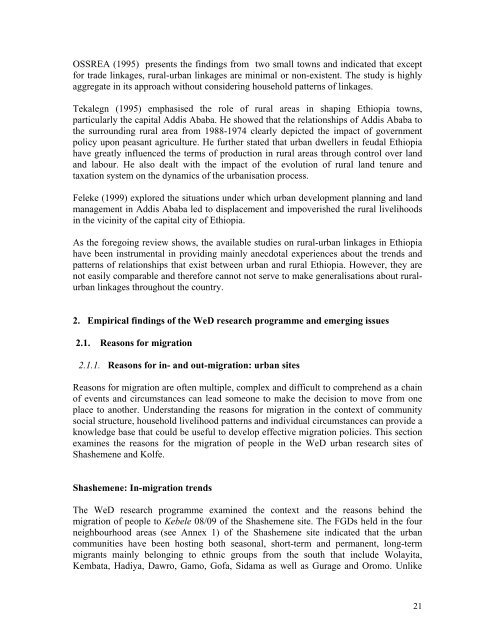Migration and Rural-Urban Linkages in Ethiopia
Migration and Rural-Urban Linkages in Ethiopia - Ethiopian Review
Migration and Rural-Urban Linkages in Ethiopia - Ethiopian Review
Create successful ePaper yourself
Turn your PDF publications into a flip-book with our unique Google optimized e-Paper software.
OSSREA (1995) presents the f<strong>in</strong>d<strong>in</strong>gs from two small towns <strong>and</strong> <strong>in</strong>dicated that exceptfor trade l<strong>in</strong>kages, rural-urban l<strong>in</strong>kages are m<strong>in</strong>imal or non-existent. The study is highlyaggregate <strong>in</strong> its approach without consider<strong>in</strong>g household patterns of l<strong>in</strong>kages.Tekalegn (1995) emphasised the role of rural areas <strong>in</strong> shap<strong>in</strong>g <strong>Ethiopia</strong> towns,particularly the capital Addis Ababa. He showed that the relationships of Addis Ababa tothe surround<strong>in</strong>g rural area from 1988-1974 clearly depicted the impact of governmentpolicy upon peasant agriculture. He further stated that urban dwellers <strong>in</strong> feudal <strong>Ethiopia</strong>have greatly <strong>in</strong>fluenced the terms of production <strong>in</strong> rural areas through control over l<strong>and</strong><strong>and</strong> labour. He also dealt with the impact of the evolution of rural l<strong>and</strong> tenure <strong>and</strong>taxation system on the dynamics of the urbanisation process.Feleke (1999) explored the situations under which urban development plann<strong>in</strong>g <strong>and</strong> l<strong>and</strong>management <strong>in</strong> Addis Ababa led to displacement <strong>and</strong> impoverished the rural livelihoods<strong>in</strong> the vic<strong>in</strong>ity of the capital city of <strong>Ethiopia</strong>.As the forego<strong>in</strong>g review shows, the available studies on rural-urban l<strong>in</strong>kages <strong>in</strong> <strong>Ethiopia</strong>have been <strong>in</strong>strumental <strong>in</strong> provid<strong>in</strong>g ma<strong>in</strong>ly anecdotal experiences about the trends <strong>and</strong>patterns of relationships that exist between urban <strong>and</strong> rural <strong>Ethiopia</strong>. However, they arenot easily comparable <strong>and</strong> therefore cannot not serve to make generalisations about ruralurbanl<strong>in</strong>kages throughout the country.2. Empirical f<strong>in</strong>d<strong>in</strong>gs of the WeD research programme <strong>and</strong> emerg<strong>in</strong>g issues2.1. Reasons for migration2.1.1. Reasons for <strong>in</strong>- <strong>and</strong> out-migration: urban sitesReasons for migration are often multiple, complex <strong>and</strong> difficult to comprehend as a cha<strong>in</strong>of events <strong>and</strong> circumstances can lead someone to make the decision to move from oneplace to another. Underst<strong>and</strong><strong>in</strong>g the reasons for migration <strong>in</strong> the context of communitysocial structure, household livelihood patterns <strong>and</strong> <strong>in</strong>dividual circumstances can provide aknowledge base that could be useful to develop effective migration policies. This sectionexam<strong>in</strong>es the reasons for the migration of people <strong>in</strong> the WeD urban research sites ofShashemene <strong>and</strong> Kolfe.Shashemene: In-migration trendsThe WeD research programme exam<strong>in</strong>ed the context <strong>and</strong> the reasons beh<strong>in</strong>d themigration of people to Kebele 08/09 of the Shashemene site. The FGDs held <strong>in</strong> the fourneighbourhood areas (see Annex 1) of the Shashemene site <strong>in</strong>dicated that the urbancommunities have been host<strong>in</strong>g both seasonal, short-term <strong>and</strong> permanent, long-termmigrants ma<strong>in</strong>ly belong<strong>in</strong>g to ethnic groups from the south that <strong>in</strong>clude Wolayita,Kembata, Hadiya, Dawro, Gamo, Gofa, Sidama as well as Gurage <strong>and</strong> Oromo. Unlike21




![to read the full report [pdf, Amharic] - Ethiopian Review](https://img.yumpu.com/52737829/1/190x245/to-read-the-full-report-pdf-amharic-ethiopian-review.jpg?quality=85)











